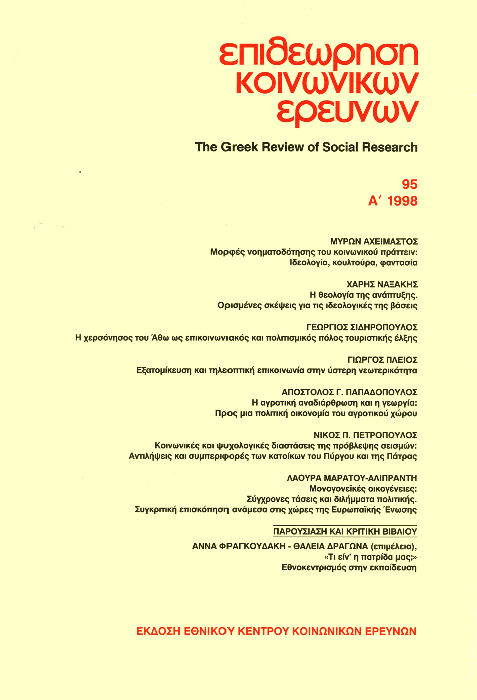Η χερσόνησος του Άθω ως επικοινωνιακός και πολιτισμικός πόλος τουριστικής έλξης
Abstract
Το Άγιον Όρος αποτελεί τη μεγαλύτερη ζώσα άθροίση ορθόδοξης κληρονομιάς, συγκεντρωμένη σε περιορισμένο χώρο, και μία από τις κυριότερες ζώνες στον κόσμο ιστορικής και πολιτισμικής σημασίας. Τα χαρακτηριστικά του αυτά το καθιστούν σημείο απόληξης ενός ιδιαίτερου επισκεπτικού ρεύματος. Η απομόνωση, όμως, χάριν της οποίας οι κάτοικοι του Άθω επέλεξαν τη χερσόνησο, τείνει να προσβληθεί ανεπανόρθωτα συνεπεία της αύξησης του τουριστικού ρεύματος.
Για τη διαφύλαξη τον παράλληλου χαρακτήρα τον, ως πολιτισμικού αντικειμένου και ως ζωντανού οργανισμού, έχουν θεσπιστεί αρχές διακριτικού ελέγχου του τουριστικού ρεύματος, ώστε να μη θιγούν οι στοιχειώδεις ελευθερίες που θα του επιτρέψουν να συνεχίσει τη μακρόχρονη πορεία και την ιδιαιτερότητά τον, τόσο σημαντική για τον παγκόσμιο πολιτισμό.
Article Details
- How to Cite
-
Σιδηρόπουλος Γ. (1998). Η χερσόνησος του Άθω ως επικοινωνιακός και πολιτισμικός πόλος τουριστικής έλξης. The Greek Review of Social Research, 95, 69–85. https://doi.org/10.12681/grsr.722
- Issue
- 1998: 95 Α'
- Section
- Articles

This work is licensed under a Creative Commons Attribution-NonCommercial 4.0 International License.
Authors who publish with this journal agree to the following terms:
- Authors retain copyright and grant the journal right of first publication with the work simultaneously licensed under a Creative Commons Attribution Non-Commercial License that allows others to share the work with an acknowledgement of the work's authorship and initial publication in this journal.
- Authors are able to enter into separate, additional contractual arrangements for the non-exclusive distribution of the journal's published version of the work (e.g. post it to an institutional repository or publish it in a book), with an acknowledgement of its initial publication in this journal.
- Authors are permitted and encouraged to post their work online (preferably in institutional repositories or on their website) prior to and during the submission process, as it can lead to productive exchanges, as well as earlier and greater citation of published work (See The Effect of Open Access).



